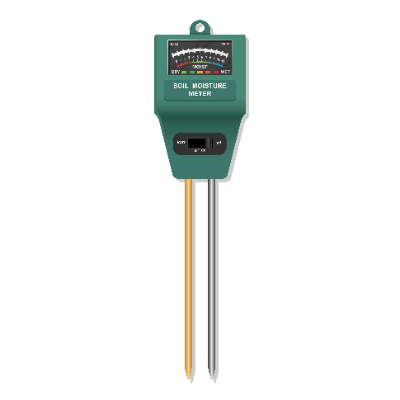What Is a Soil Moisture Meter?

Soil moisture meters are used to measure the amount of moisture contained in the soil. They are mainly used to check soil properties and management conditions in the agricultural field, agricultural research and development, environmental monitoring associated with construction work (vegetation protection, etc.), and personal gardening.
Depending on the principle of measurement, some types use the dielectric constant (TDR, ADR, and FDR methods), tensiometer, and cyclometer methods. There is also a logger type that, when buried in soil, periodically measures data and stores it in the main unit. Since electronic moisture sensors are available at low cost, there are also applications for making your own soil moisture meter.
Uses of Soil Moisture Meters
Soil moisture is widely used as an indicator in agriculture because it is an important factor in determining plant growth. In the case of potted plants and gardening, too high a soil moisture content can cause root rot, so soil moisture meters are widely used by professionals and homeowners alike.
Soil moisture meters are based on a variety of principles and come in a wide price range, so it is necessary to choose the right type for your application and the accuracy of the data you need. Some meters can be purchased for as little as a few dollars per unit, while others cost hundreds of dollars.
Principle of Soil Moisture Meters
The main methods used in soil moisture meters are as follows:
1. TDR (Time Domain Reflectometry) Method, ADR (Amplitude Domain Reflectometry) Method, and FDR (Frequency Domain Reflectometry)
The basic principle of all of these methods is the same: soil moisture is measured by a dielectric constant. Soil consists of water, air, and soil particles (minerals and dead plants and animals). The dielectric constant of each material is much higher for water than for other materials, and the dielectric constant of the soil itself has a constant relationship with the soil water content. The soil moisture content is determined from this relationship. Characteristically, the ADR method is cheaper in equipment and easier to operate than other methods (FDR and TDR). On the other hand, the TDR method or soil is not affected by temperature unless it freezes, making it suitable for use in environments where temperatures are not stable.
2. Tensiometer Method
A container made of unglazed parts called a porous cup, is inserted into the soil for measurement. The container is filled with water, and the amount of water that oozes out is measured as pressure. This method uses the water tension of the soil. This method is widely used in the industrial field, but its disadvantage is that it is time-consuming.
3. Cyclometer Method
This method uses thermocouples in the soil to evaluate the soil. The relative vapor pressure of air in equilibrium with water in the soil is measured to calculate soil moisture. Because it can also measure the moisture content of plant tissue, it has a wide range of applications, but because it is a precision instrument, it is very expensive, costing several thousand dollars per unit.